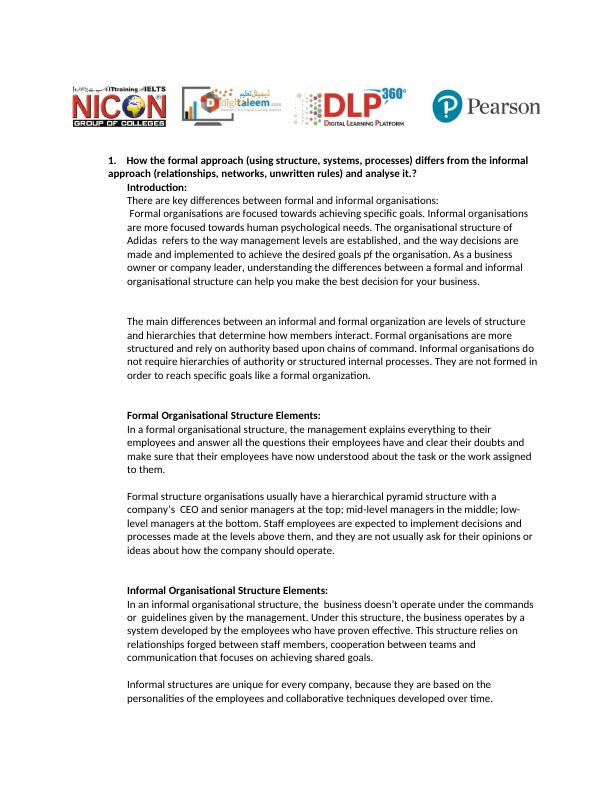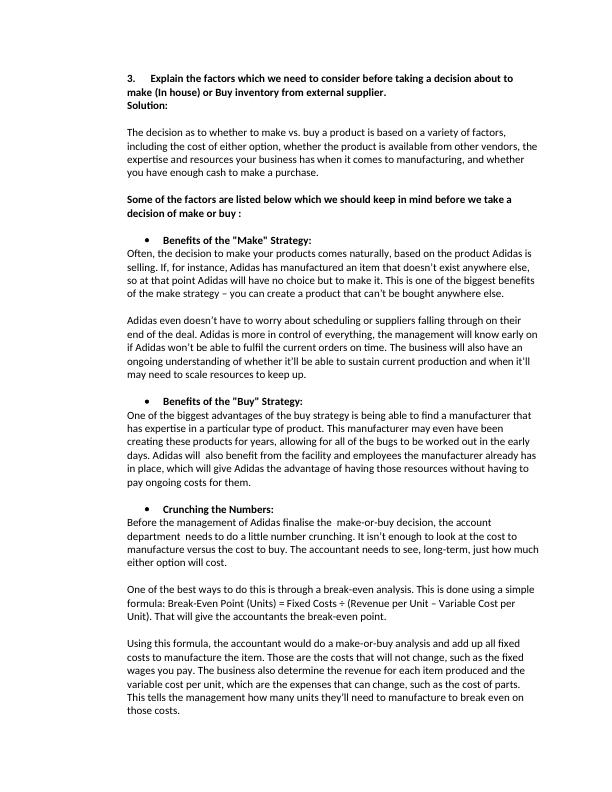Organisational Structure Elements - PDF
4 Pages1791 Words160 Views
Added on 2021-02-22
Organisational Structure Elements - PDF
Added on 2021-02-22
ShareRelated Documents
1. How the formal approach (using structure, systems, processes) differs from the informal approach (relationships, networks, unwritten rules) and analyse it.?Introduction: There are key differences between formal and informal organisations: Formal organisations are focused towards achieving specific goals. Informal organisations are more focused towards human psychological needs. The organisational structure of Adidas refers to the way management levels are established, and the way decisions are made and implemented to achieve the desired goals pf the organisation. As a business owner or company leader, understanding the differences between a formal and informal organisational structure can help you make the best decision for your business.The main differences between an informal and formal organization are levels of structure and hierarchies that determine how members interact. Formal organisations are more structured and rely on authority based upon chains of command. Informal organisations do not require hierarchies of authority or structured internal processes. They are not formed inorder to reach specific goals like a formal organization.Formal Organisational Structure Elements:In a formal organisational structure, the management explains everything to their employees and answer all the questions their employees have and clear their doubts and make sure that their employees have now understood about the task or the work assigned to them. Formal structure organisations usually have a hierarchical pyramid structure with a company’s CEO and senior managers at the top; mid-level managers in the middle; low-level managers at the bottom. Staff employees are expected to implement decisions and processes made at the levels above them, and they are not usually ask for their opinions or ideas about how the company should operate.Informal Organisational Structure Elements:In an informal organisational structure, the business doesn’t operate under the commands or guidelines given by the management. Under this structure, the business operates by a system developed by the employees who have proven effective. This structure relies on relationships forged between staff members, cooperation between teams and communication that focuses on achieving shared goals.Informal structures are unique for every company, because they are based on the personalities of the employees and collaborative techniques developed over time.

3. Explain the factors which we need to consider before taking a decision about to make (In house) or Buy inventory from external supplier.Solution:The decision as to whether to make vs. buy a product is based on a variety of factors, including the cost of either option, whether the product is available from other vendors, theexpertise and resources your business has when it comes to manufacturing, and whether you have enough cash to make a purchase.Some of the factors are listed below which we should keep in mind before we take a decision of make or buy :Benefits of the "Make" Strategy:Often, the decision to make your products comes naturally, based on the product Adidas is selling. If, for instance, Adidas has manufactured an item that doesn’t exist anywhere else, so at that point Adidas will have no choice but to make it. This is one of the biggest benefits of the make strategy – you can create a product that can’t be bought anywhere else.Adidas even doesn’t have to worry about scheduling or suppliers falling through on their end of the deal. Adidas is more in control of everything, the management will know early onif Adidas won’t be able to fulfil the current orders on time. The business will also have an ongoing understanding of whether it’ll be able to sustain current production and when it’ll may need to scale resources to keep up.Benefits of the "Buy" Strategy:One of the biggest advantages of the buy strategy is being able to find a manufacturer that has expertise in a particular type of product. This manufacturer may even have been creating these products for years, allowing for all of the bugs to be worked out in the early days. Adidas will also benefit from the facility and employees the manufacturer already has in place, which will give Adidas the advantage of having those resources without having to pay ongoing costs for them.Crunching the Numbers:Before the management of Adidas finalise the make-or-buy decision, the account department needs to do a little number crunching. It isn’t enough to look at the cost to manufacture versus the cost to buy. The accountant needs to see, long-term, just how mucheither option will cost.One of the best ways to do this is through a break-even analysis. This is done using a simple formula: Break-Even Point (Units) = Fixed Costs ÷ (Revenue per Unit – Variable Cost per Unit). That will give the accountants the break-even point.Using this formula, the accountant would do a make-or-buy analysis and add up all fixed costs to manufacture the item. Those are the costs that will not change, such as the fixed wages you pay. The business also determine the revenue for each item produced and the variable cost per unit, which are the expenses that can change, such as the cost of parts. This tells the management how many units they’ll need to manufacture to break even on those costs.

End of preview
Want to access all the pages? Upload your documents or become a member.
Related Documents
Relationship between Organisational Goals, Objectives, and Policies in the Joy of Chocolate Case Studylg...
|4
|1315
|97
Organizational Structure and Mission Statements for Whitlam Memorial Hospitallg...
|8
|2127
|161
Introduction to Management: Structure, Functions, and HR Managementlg...
|10
|2046
|318
Mechanistic Structure and Decision Making in Health Care Organizationslg...
|6
|1071
|390
Bureaucratic Organisation Structurelg...
|9
|2326
|82
Formal and Informal Modes of Communication and Organizational Culturelg...
|11
|2024
|132
